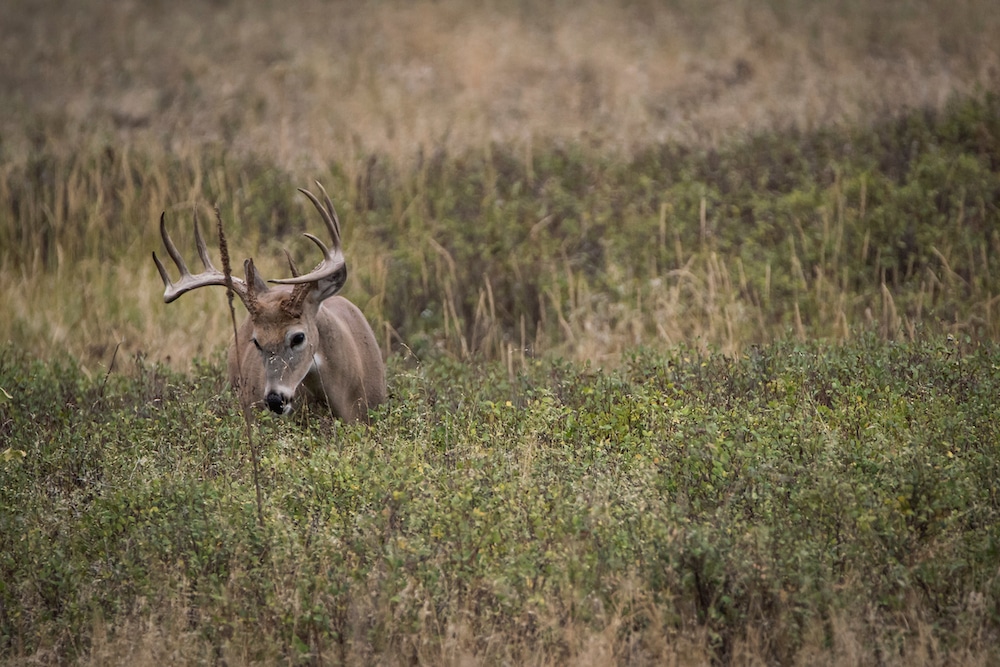Many bowhunters plant food plots to bolster deer nutrition, but they may be missing the big picture. Deer consume about 8 pounds of food per 100 pounds of body weight, per day. Planting and enhancing native vegetation can provide a much larger forage base and really benefit the local deer herd, as well as other species.
Whitetails are known to eat a few hundred different plant species, but they have a hierarchy of preferences no matter where they live. Plants they consume may be highly desirable, moderately desirable or a last-resort food, and those preferences can change by the season.
Deer prefer forbs, which are soft-stemmed flowering plants that are often called weeds, including plantain, aster, goldenrod, blackberry, vetch and many others. Forbs are highly digestible and high in protein, vital minerals and antioxidants. However, many are seasonal, available only in spring and summer. Another big component of a deer’s diet is browse, which includes leaves and twigs from woody plants. Browse is important all year long, but particularly so in fall and winter, when other food sources are less abundant. Rounding out the list are mast — fruit and nuts — and mushrooms, which deer love. Deer do consume some grasses as well, but mostly when it’s fresh growth. A deer’s stomach isn’t designed to mow down grass like a cow’s stomach.

Deer gravitate toward forbs. Photo Credit: John Hafner
If you want to increase the availability of native deer foods in your area, good resources include your local forester, wildlife biologist and county extension office. Through them, you’ll learn which plant hardiness zone you live in, which plant species grow best in your area and which species local deer prefer.
Although your first inclination may be to plant native foods for deer, it’s often easier to just give Mother Nature a nudge. Cutting mature trees to open up the forest floor often jump-starts plant growth, creating a whitetail bonanza. You may even consider fertilizing the area to maximize plant growth. Performing a prescribed burn can have the same effect, as it opens up the existing seedbank and allows some dormant species to germinate. However, don’t attempt a prescribed burn if you’re not experienced!
Planting mast trees such as oak, beech, apple, crabapple, plum, persimmon and others provides great whitetail food. Think of these species as a long-term investment in food sources, since they take time to bear fruit. In other words, plant today for tomorrow’s mast production. Also, prune and fertilize existing mast trees for increased production.
Mowing overgrown fields can often clear out nonnative grasses and make way for more beneficial forbs. Selective application of herbicides can further set back undesirable plants and pave the way for more desirable species. If efforts like thinning, mowing or burning don’t produce the results you’re after, you may consider planting. You can purchase seed mixes with native forbs and grasses mixed in. Make sure you’re planting native species that deer prefer, as nonnative species can actually outcompete desirable, native species. Consult your local co-op regardless of your plan.

Consider planting varying vegetation that will provide deer with a food source all year. Photo Credit: John Hafner
Keep in mind, it’s not all about food. Deer also need protection from predators and the elements. Consider planting evergreen trees like pines and cedars as shelter from snow and rain. Plant or enhance brushy thickets for fawning cover. Some native grass varieties can also provide bedding cover. Switchgrass is best because it remains standing, even after windstorms and heavy snow. Some species such as red-osier dogwood double as both food and cover. Deadfalls from strategically dropped trees make instant security cover.
When you’re improving the native landscape, consider the year-round benefits. For example, mast trees are great, but they only provide food for a short window each fall. So don’t forget to plant or enhance forbs for warm-season nutrition, mast trees for a fall crop, and help out or plant native trees like aspen or cedar for winter browse.
Deer will quickly find newly planted or enhanced food sources, and too much browsing pressure too soon can destroy your efforts. Therefore, you may have to fence off some plants, allowing them time to establish themselves before deer graze them to the ground. Planting or enhancing habitat in rotating blocks can ensure some areas have established plant growth while others are newly forming at any given time, which can spread out grazing’s influence.
Here are some further helpful resources:
Outdoor Life: “Go Native: 6 Indigenous Plants for Your Next Food Plot”
https://www.outdoorlife.com/photos/gallery/hunting/2012/03/stop-relying-invasive-weeds-grow-deer/
National Deer Association: “Know Your Native Deer Foods”
https://www.deerassociation.com/know-native-deer-foods/
Natural Resources Conservation Texas Forestry Technical Note, TX-FS-12-1
https://www.nrcs.usda.gov/Internet/FSE_DOCUMENTS/nrcs144p2_002336.pdf
North American Whitetail Magazine: “What Do Deer Eat?”
https://www.northamericanwhitetail.com/editorial/whitetail-101-what-do-deer-eat/262416
University of Missouri Extension: “Enhancing White-Tailed Deer Habitats on Your Property: Early Successional Vegetation”
https://extension.missouri.edu/publications/g9494